Do you dream of baking incredibly tender, soft, and moist cakes? The secret ingredient for many professional bakers is cake flour. But what if you don’t have any on hand? Don’t worry! You can easily learn How To Make Cake Flour at home with just two simple ingredients. This guide will show you exactly how to create a perfect cake flour substitute, ensuring your cakes turn out flawlessly every time.
Understanding Cake Flour and Its Importance
Cake flour is a specialized type of flour that is key to achieving that delicate crumb in cakes. What sets it apart from all-purpose flour? It primarily comes down to protein content. Cake flour has a significantly lower protein content compared to all-purpose flour, typically around 7-9% versus 10-12% in all-purpose.
This lower protein level is crucial because it results in less gluten development when you mix your cake batter. Gluten, while important for chewy breads, can make cakes tough and dense. By using cake flour, you minimize gluten formation, leading to cakes that are exceptionally tender and have a melt-in-your-mouth texture. Cake flour is also often bleached, which further weakens the gluten and brightens the crumb of your baked goods.
Another characteristic of cake flour is its fine texture. It’s often sifted multiple times during production, making it lighter than all-purpose flour. In fact, one cup of cake flour weighs approximately 4 ounces, while the same volume of all-purpose flour weighs about 4 ½ ounces. This difference in density can impact your baking, especially when substituting flours.
Key Ingredients for Homemade Cake Flour
Making your own cake flour at home is surprisingly simple and requires just two pantry staples:
- All-Purpose Flour: This forms the base of your cake flour substitute. It’s important to use standard, unbleached or bleached all-purpose flour.
- Cornstarch: This is the magic ingredient that lowers the protein content and mimics the properties of cake flour.
That’s it! With just these two ingredients, you can create a DIY cake flour that works wonders in your cake recipes.
Step-by-Step Guide: Making Your Cake Flour Substitute
Here’s a simple method to transform all-purpose flour into cake flour substitute:
- Measure Your All-Purpose Flour: For every cup of cake flour your recipe calls for, start by measuring out one level cup of all-purpose flour. Ensure you are using a dry measuring cup and level off the excess flour with a straight edge.
- Remove Flour: Take out 2 tablespoons of all-purpose flour from the measured cup. This reduction is crucial for creating the right protein ratio.
- Add Cornstarch: Replace the removed flour with 2 tablespoons of cornstarch. Level the cornstarch in the measuring spoon to ensure accuracy.
- Sift Thoroughly: This is a vital step! Sift the flour and cornstarch mixture together 4-5 times. Sifting ensures that the cornstarch is evenly distributed throughout the flour and helps to lighten the mixture, mimicking the texture of commercial cake flour.
Why This Works:
The process of removing a portion of all-purpose flour and adding cornstarch effectively reduces the overall protein content of the mixture, bringing it closer to that of cake flour. Cornstarch is a pure starch and contains very little protein. Furthermore, sifting aerates the mixture, resulting in a lighter, finer flour, much like commercially produced cake flour.
When to Use Your Homemade Cake Flour
Now that you know how to make cake flour, when should you use it? Cake flour is ideal for recipes where a tender, delicate crumb is desired. This includes:
- Layer Cakes: Especially classic vanilla, white, or delicate flavored cakes where a soft texture is paramount.
- Cupcakes: For cupcakes that are light and airy rather than dense and chewy.
- Pound Cakes: While pound cakes are traditionally denser, using cake flour can create a slightly more refined and less heavy texture.
- Angel Food Cake & Sponge Cake: These cakes rely heavily on a light and airy texture, and cake flour is often essential.
Using cake flour (or your homemade version) in these recipes will significantly improve the final texture, giving you bakery-quality results at home.
Conclusion: Bake Softer Cakes Today!
Knowing how to make cake flour at home is a game-changer for any baker. No more last-minute trips to the store when you’re in the mood for baking! With just all-purpose flour and cornstarch, you can easily create a substitute that will help you achieve incredibly soft and tender cakes. Try this simple technique and elevate your baking to the next level. Your friends and family will be amazed by the improved texture of your homemade cakes!
